Keema Curry is a great recipe for using mince.
It’s tasty, inexpensive and easy to adapt to suit any taste or budget.
My recipe is not only simple, it can also be made in advance to keep in the fridge or freezer.
In fact, keema is one of those dishes that tastes better the next day!

This Keema Curry recipe is…
- VEGAN
- EASILY ADAPTABLE FOR GLUTEN-FREE DIETS
- NUT FREE
- LOW COST
- HIGH PROTEIN
- GREAT FOR MEAL PREP
What is Keema Curry?

Keema Curry, or Keema Masala (sometimes spelt Qeema or Kheema) is a dish that consists of mince (typically lamb or beef) and spices.
It’s a popular everyday dish throughout the Indian subcontinent, and in parts of Central Asia.
Today, we’re making a plant-based or vegan keema using soya and a range of incredible, warming spices.
All the spices in this curry recipe are easy to find in most countries. However, if you can’t source one, simply leave it out.
It’s a very forgiving dish!
What are the best spices for keema?

For this keema recipe, I use ground coriander, cumin, smoked paprika, turmeric and garam masala.
These are the basic spices you’ll need to make a flavoursome keema.
If you would like to make the dish more elaborate, try adding a few whole spices such as a cinnamon stick, cloves, black cardamom or kasoori methi (dried fenugreek leaves).
You could also sprinkle the keema with a pinch of amchur (dried mango powder).
Get ahead and make your own keema masala
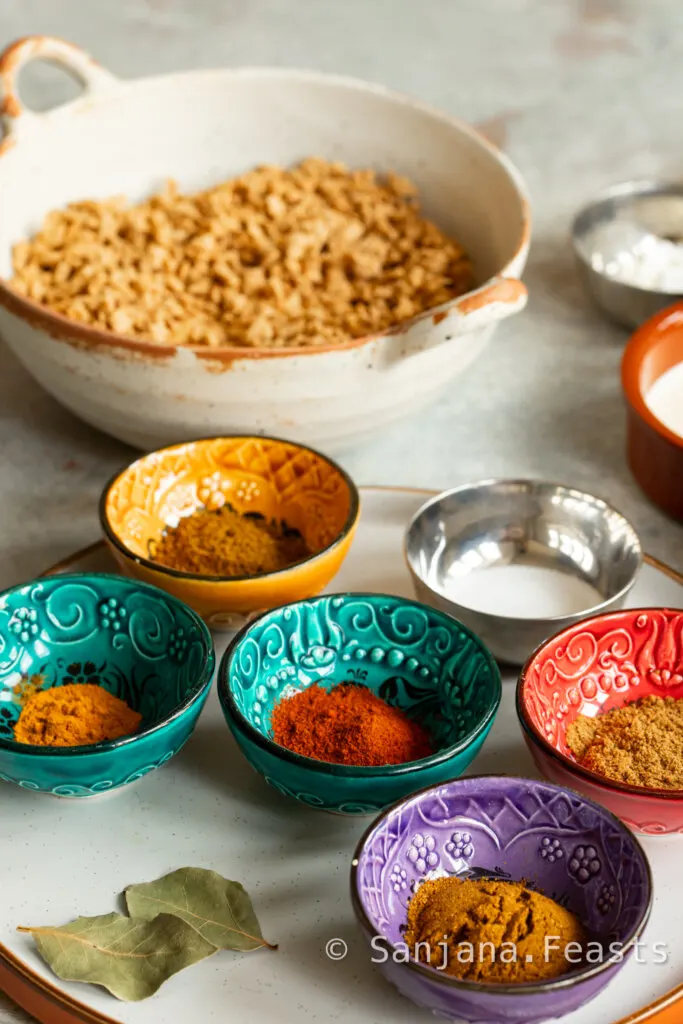
What is keema masala?
Keema masala can be bought right off the shelf in any Indian supermarket.
However, it’s also incredibly easy to make your own keema masala from scratch!
Simply mix a big batch of the dried spices in the recipe card below together and store in an airtight container.
This homemade keema masala will be ready to sprinkle in to keema curry whenever you feel like it.
No faffing about with individual spices!
Where did keema come from?
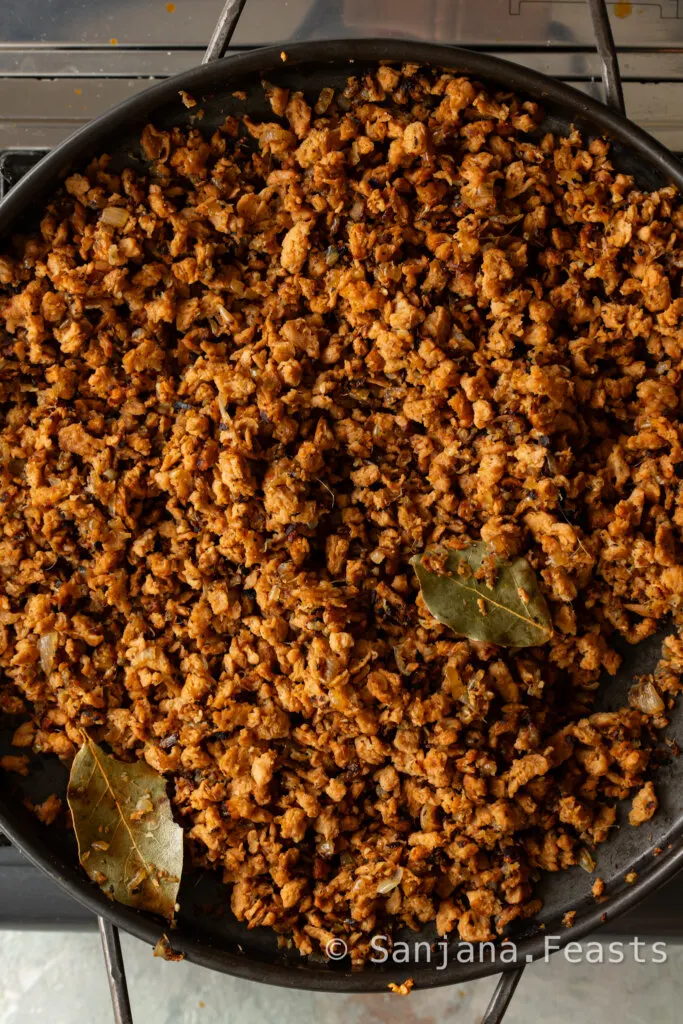
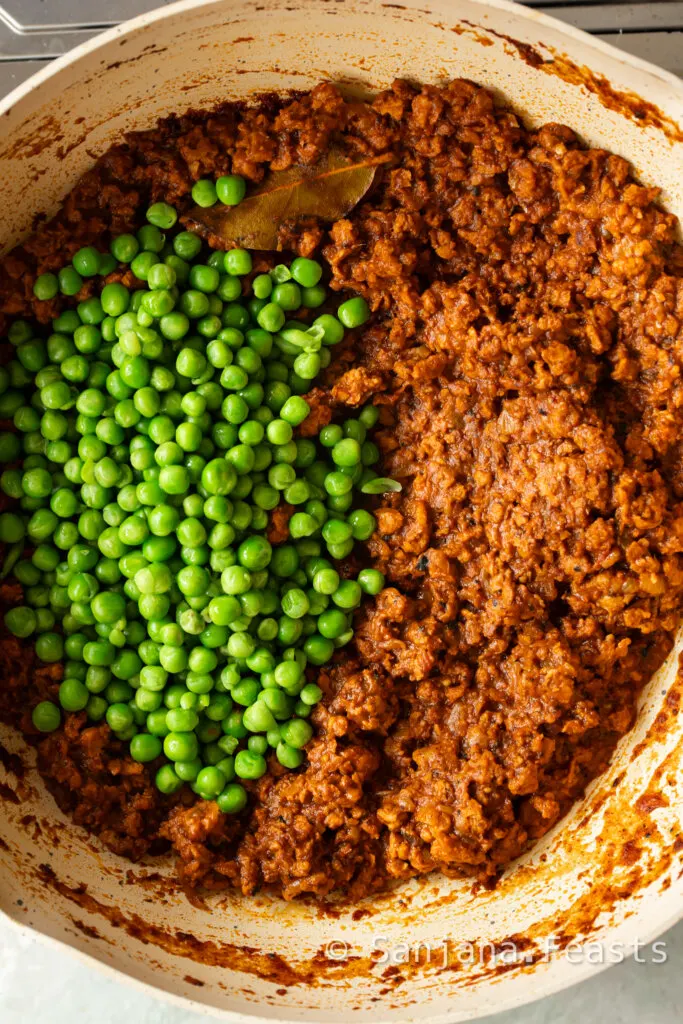
Keema is a delicious and hearty dish of minced meat that is popular in many parts of the world, but it’s especially popular in the Indian subcontinent.
The word ‘keema’ is said to come from the Turkish word ‘kiyma’, which simply means ‘minced meat’.
It’s thought that the dish was brought to India by the Mughals, who were a Persian-speaking Muslim dynasty that ruled India from the 16th to the 18th centuries.
The Mughals were known for their love of fine food, and they introduced many new dishes to the Indian subcontinent, including keema.



Some famous Mughalai dishes you’ll recognise are korma (qorma), biryani, nihari, kebabs and kofta.
Keema can be made with any type of minced meat (or plant alternative), but lamb is the most traditional.
The protein is usually cooked with onions, spices, and tomatoes, and it can be served as a main course or as a filling for samosas or parathas.
There are many different variations of keema.
Some of the most popular include keema masala (keema curry), keema matar (keema with peas), keema aloo (keema with potatoes) and keema pao (keema with dinner rolls).
The word ‘keema’ is also used in other languages, such as Urdu, Punjabi, and Hindi.
For similar reasons, Keema is also a prominent ingredient in the cuisine of East Africa.
Here it’s used for samosas (sambusa), kebabs, omelettes and in various street foods.
Vegan Keema Curry: High protein curry recipe
Did you know that this flavoursome Indian keema is packed with protein?
Best of all, my recipe is totally vegan and easily adaptable to gluten free diets (just skip the soy sauce or swap it for tamari).
The recipe does contain soya so if this is an ingredient you want to avoid, simply substitute the mince for seitan (wheat gluten), or a pea protein-based alternative.
This recipe for keema masala contains 22 grams of protein per serving.
What types of soya can I use for Keema Curry?

Dried soy mince or TVP (textured vegetable protein), frozen soy mince or seitan, mashed firm tofu or crumbled tempeh all work very well.
Any style of plant protein are delicious in this dish.
Choose an ingredient that best suits your preferences.
What are some different ways to serve keema?
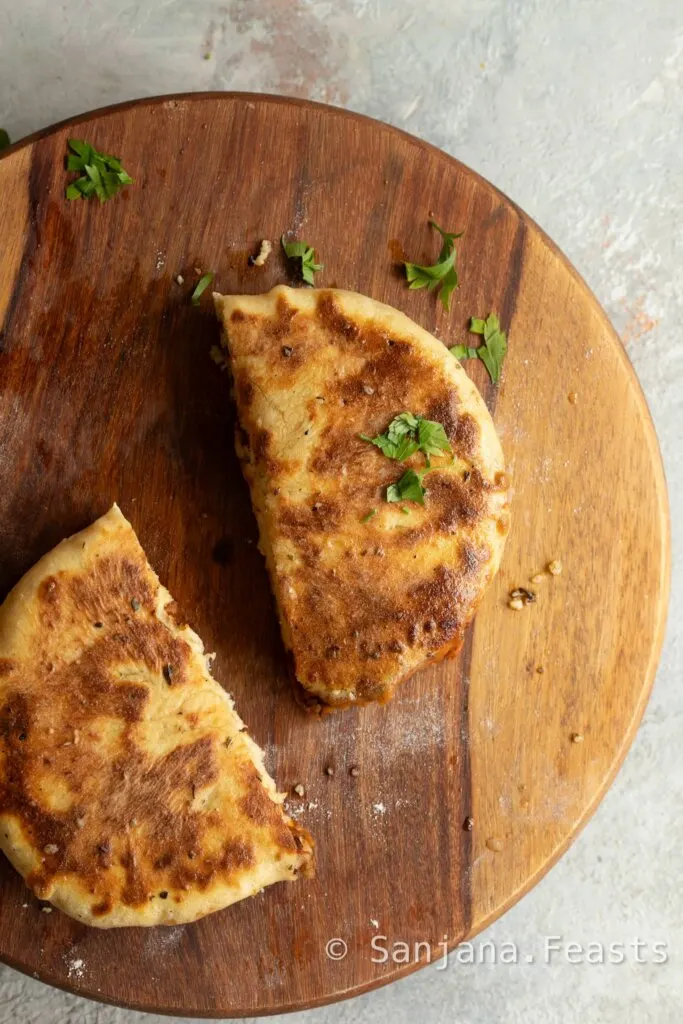
Keema Curry is delicious with any type of bread, rice, or even pasta.
Serve keema with: Naan, roti, paratha, rice, toasted rolls, buttered sliced toast or pasta!
For a low carb and gluten free option, try it with natural yoghurt, cauliflower rice, gluten-free roti, wraps or cottage cheese.
Can I add any other veggies?


Feel free to add any vegetables you like to this dish. It’s even great with beans or legumes.
Carrots, kidney beans, corn, potatoes and spinach are all delicious in this keema recipe.
How to cook keema without making it dry
A dry keema is certainly desirable for certain dishes, such as when you’re using it as a stuffing for paratha.
However, a to give traditional Keema Curry a luscious texture, I have special trick.
Curry slurry! Sounds awful, works like an absolute dream.
To cook keema without making it dry, first mix together cream and cornflour (cornstarch) to create a slurry.
Add this to the curry and stir. Watch the keema transform from dry and crumbly to velvety, rich and juicy right before your eyes.
This technique is borrowed from the Italian method of making bolognese that is luscious, with a very delicate creaminess.
Helpful equipment for this recipe
This post contains Amazon Affiliate links. These are all products I have purchased of my own accord and ones that I use myself. None of the products mentioned have been gifted to me. By using an affiliate link, I receive a small commission at no expense to you. This commission helps to support this blog. Thanks in advance if you choose to make a purchase through these links!
Ingredients for Keema Curry
Dob’t be put off by the list of ingredients. Most are store-cupboard items or easy to omit/substitute.
- Soya mince – dried, fresh or frozen plant-based mince of your choice
- Peas – Use frozen or canned for convenience
- Onions – large brown or red onions
- Oil – any neutral oil such as sunflower, canola (rapeseed) or vegetable
- Dried bay leaves – Indian bay leaves, also called tej patta (optional)
- Smoked paprika – hot smoked paprika if you like it spicy, or use mild
- Ground cumin – available at most supermarkets
- Ground coriander – available at most supermarkets
- Garam masala – a blend of warming Indian available at most supermarkets or online. Alternatively, use my homemade garam masala recipe to make your own
- Turmeric – adds a wonderful colour to the curry
- Garlic – skip if you’re not a fan of garlic
- Ginger – this gives the curry a delicious freshness. Use a pinch of dried ginger if you don’t have any fresh
- Dark soy sauce – or tamari for a gluten-free option. Adds a savoury flavour since this is a vegan recipe
- Canned chopped tomatoes or passata – tomatoes create a delicious, tangy sauce for the mince
- Oat cream – or milk for a lighter option
- Cornflour (cornstarch) – to thicken the curry
- Chopped coriander (cilantro) leaves – fresh is best but omit if you don’t like coriander
- Chopped mint leaves – dried mint is fine to use too
- Salt – to season the keema
- Sugar – balances the tartness of the canned tomatoes
- Water – you’ll need hot water to soak the mince, plus more for the curry
- Green chillies, mint, fried onions and plant-based butter (optional garnishes)
How to make Keema Curry (step-by-step tutorial with pictures)
1. Soak the mince


If you are using dried soya mince, soak it in hot water for 10 minutes to rehydrate.
Rinse under cold running water and squeeze well to remove the foamy residue.
Squeeze the mince until it’s very dry and set aside.
If you’re using anything other than dried mince, you can skip this step.
2. Caramelise the onions

Browning onions forms the basis of many great curries. Keema is no different.
The process of caramelising onions is called bhuno and it creates the essential flavour foundation for this dish.

Brown the onions along with salt and sugar over a medium heat, until they are golden brown, but not burnt. Stir often.
3. Add the aromatics
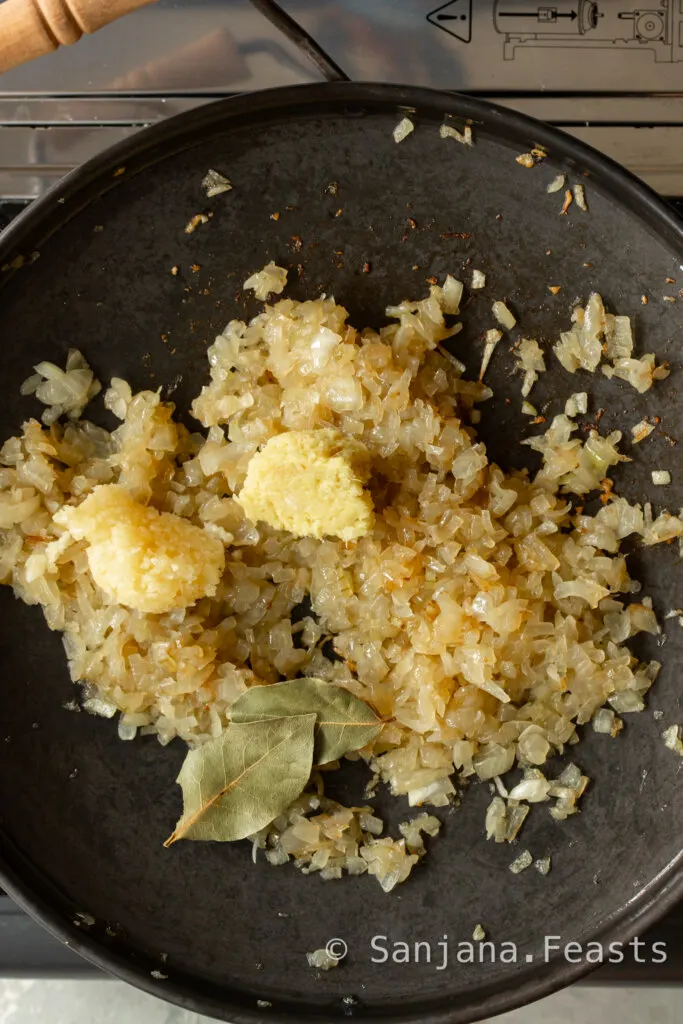
Aromatics like garlic and ginger take less time to cook than onions, so add them once the onions are brown.
This is also the point at which to add bay leaves.
4. Brown the mince

To give the mince a deliciously craggy, golden colour and bags of flavour, brown it with the onions.
Add it to the pan and saute for up to 10 minutes, until nicely browned.
Set the mince aside.
5. Make the thickener for the sauce

I like my keema curry to be juicy. To give it a luscious, velvety texture, I mix cream and cornflour (cornstarch) together.
This technique comes from an Italian method of preparing bolognese or ragu.

The fat from the cream keeps the protein soft and succulent and the cornflour thickens the sauce for a rich and unctuous texture.
To prepare special thickener, stir together the cold cream (or milk) and cornflour together in a small bowl.
5. Cook the keema curry

Heat oil in a large pan until just warm. Add the ground spices except for the garam masala. Ensure the oil isn’t too hot as they can burn quickly.



Add the tomatoes, soy sauce, mince, cream-cornflour mixture, garam masala and around 250ml water.
Mix the curry well and cover with a lid. Simmer over a medium-low heat for at least 20 minutes, or longer if you have time.


The longer you cook the curry, the more delicious it will be.
6. Add the peas


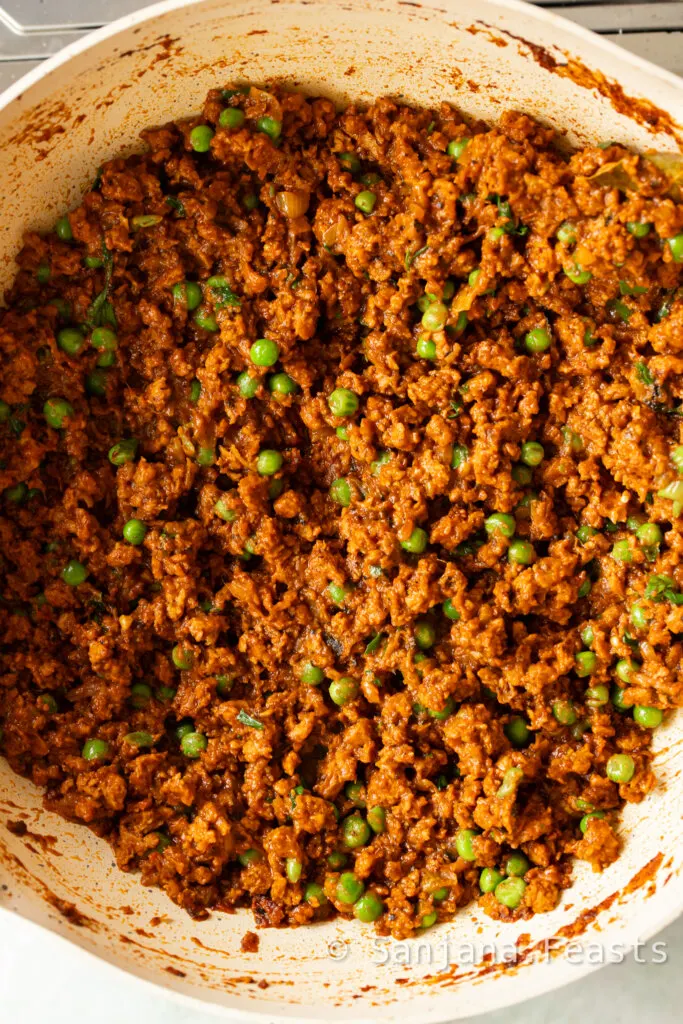
Add the peas during the final 5 minutes of cooking so that they retain their vibrant green colour.
7. Garnish and serve

Finish the keema with fresh coriander, mint, green chillies, fried onions and butter of your choice (optional).
Serve hot. I like mine with my two-bite chilli naans! Let me know in the comments if you’d like the recipe for these.
Keema Curry Recipe | How to make Vegan Keema Curry | Indian Keema Masala with video
Keema Curry (Vegan)

Unbelievable! This deeply flavoursome Indian Keema Curry features plant-based mince (soya mince), warming spices and fresh herbs. It's packed with protein and highly versatile. Enjoy it with naan, roti, rice... or even in hot sandwiches! A great vegetarian and vegan Keema recipe for batch cooking. It freezes beautifully, making it an excellent emergency meal for busy schedules. This is one of my go-to dinners all year round.
Ingredients
- 150g dried soya mince (or use 400g fresh or frozen plant-based mince)
- 225g frozen peas
- 2 large onions, finely diced
- 3 tbsp oil (any neutral), divide
- 2 dried bay leaves (optional)
- 2 tsp smoked paprika (hot or mild)
- 2 tsp ground cumin
- 2 tsp ground coriander
- 1 tbsp garam masala
- 1/2 tsp ground turmeric
- 4 large cloves garlic, crushed
- 1 tbsp grated ginger
- 1 tbsp dark soy sauce (or tamari for a gluten-free option)
- 1 x 400g can chopped tomatoes or passata
- 50ml oat cream (or milk for a lighter option)
- 1 1/2 tsp cornflour (cornstarch)
- 2 tbsp chopped coriander leaves
- 1 tbsp chopped mint leaves
- 1 tsp salt
- 1 tsp sugar
- 250ml water
- Chopped green chillies, mint and fried onions (garnish, optional)
- Plant-based butter (to serve, optional)
Instructions
- Place the soya mince in a large bowl and cover with enough hot water to fully submerge. Allow to stand for 10 minutes. Tip the mince into a fine-holed sieve or colander and rinse with plenty of cold running water. Squeeze the mince very well to remove the foamy liquid. Once the mince is squeezed dry, place it into a bowl and set aside. Skip this step if using fresh or frozen mince.
- Heat the oil in a large, heavy-based pan. Add 2 tablespoons of the oil, onions, salt and sugar. Sauté the onions until they're golden brown, around 10 minutes.
- Add the garlic, ginger and bay leaves. Continue to sauté for 1-2 minutes before adding the mince.
- Sauté the mince for 5-6 minutes over a high heat, until it turns lightly golden brown in some areas. Essentially, we are toasting the mince which will give the curry depth and flavour. Once the mince has browned and become crisp in some areas, remove it from the heat and set aside.
- In a small bowl, stir together the cream (or milk) and cornflour until no lumps remain. It will thicken slightly.
- Heat the remaining tablespoon of oil in a separate pan set over a medium-low heat. Add the ground spices (paprika, cumin, coriander and turmeric). Stir briefly, about 15 seconds before tipping in the tomatoes, prepared soya mince, cream and cornflour mixture, soy sauce and water. Mix thoroughly and set the heat to medium-low.
- Cover the pan with a lid and allow to simmer for 20 minutes (or longer - up to 40 minutes if you're not in a rush). The longer you cook it, the more flavoursome it will be.
- In the last 5 minutes of cooking, stir through the peas, mint and coriander and green chillies. Return the lid to the pan just until the peas defrost and the dish heats through. If you prefer the keema curry to be extra dry, cook uncovered for the final 5 minutes.
- Serve with additional chillies, fried onions, herbs and a dollop of plant-based butter (optional).
Notes
- For slow cookers: At step 7, instead of simmering on the stove, you can transfer the keema to a slow cooker set to low for up to 6 hours. You may need to add extra water if necessary.
- Try garnishing keema with crispy fried onions. You can make your own or buy them from the store. If you like raw onions, you can also garnish with these.
- Leftover keema can be stored in the fridge for up to 3 days.
- To freeze keema: Wait for the keema to cool completely, and then place into a freezer-safe container with a tight-fitting lid. Freeze for up to 3 months. Defros at room temperature or in the microwave. Heat the keema through before serving - it should be piping hot!
- To batch cook keema: Simply double the recipe and divide into multiple containers for freezing. I keep some to eat on the day and throughout the week and freeze the rest into two-person portions.
- If you're vegetarian but not vegan, you can prepare this keema with dairy cream and butter instead of plant-based alternatives.
- Serve keema with: Naan, roti, paratha, rice, toasted rolls, buttered sliced toast or even pasta! For a low carb and gluten free option, try it with natural yoghurt, cauliflower rice, gluten-free wraps or cottage cheese.
Nutrition Information:
Yield: 4 Serving Size: 1Amount Per Serving: Calories: 435Total Fat: 27gSaturated Fat: 7gTrans Fat: 1gUnsaturated Fat: 17gCholesterol: 41mgSodium: 930mgCarbohydrates: 32gFiber: 9gSugar: 11gProtein: 21g
Pin this recipe for later

If you like this, you’ll love my recipe for Keema Pau Bhaji
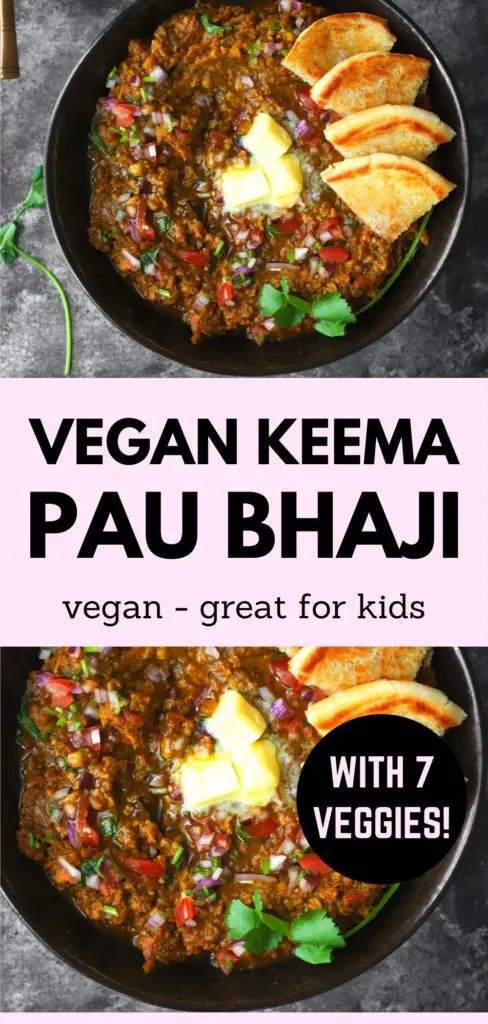
More delicious curry recipes to try
10 Paneer Curry Recipes You'll Love
Try one of these delicious paneer curry recipes the next time you're cooking up an Indian feast!
Matar Paneer
Matar Paneer is a popular Indian dish made with paneer cheese and peas in a creamy tomato-based sauce. It's a delicious and nutritious vegetarian curry.
This recipe for Matar Paneer is also easy to make, making it an amazing option for home cooks or people new to Indian food.
Matar Paneer is typically served with rice, naan or roti, but feel free to choose your favourite accompaniments.
Restaurant-Style Shahi Paneer
Soft, creamy Mughlai Restaurant-Style Shahi Paneer is a true celebration of rich flavours and treasured spices. Scoop this vegetarian curry up with hot paratha, naan or roti.
If you’re not a bread lover, this Shahi Paneer also pairs beautifully with rice, should you wish to opt for a simple curry and rice bowl for dinner.
Paneer Tikka Masala
Learn how to make the most delicious Paneer Tikka Masala, just like your favourite Indian restaurant!
Pieces of paneer (cottage cheese) and vegetables are first marinated in yoghurt and spices, and then skewered and grilled to smoky perfection.
The tikka pieces are then removed from the skewer and folded into a creamy curry sauce made with tomatoes, spices and cream. Here's an easy to follow video recipe and video.
The Ultimate Saag Paneer
The Ultimate Saag Paneer recipe is pure MAGIC! Soft paneer chunks in a creamy mustard greens & spinach curry. Every bite will melt in your mouth.
Saag Paneer is the more character-laden cousin of Palak Paneer, made with mixed greens like mustard leaves (sarson) instead of spinach alone.
The velvety texture and subtle spicing of this recipe for Saag Paneer ensures the peppery mustard leaves and juicy paneer are the true stars of the show.
Brown Butter Paneer Makhani
I thought I knew true love, but then I met Brown Butter Paneer Makhani. The toasty, nutty aroma of brown butter (or beurre noisette) transforms the traditional Paneer Makhani we all know and love into something even more sensational.
Combine aromatic spices with a creamy cashew and tomato base, gently brown some butter in a pan and create the Makhani-style sauce of your dreams. This is the only way I’ll make Paneer Makhani from now on.
Paneer Curry
Try this easy Paneer Curry recipe with a delicious mix of aromatic Indian spices. Sauté the soft cubes of Indian cottage cheese in a golden onion and tomato masala. The flavours of cumin, black pepper, ginger and garam masala add warmth and excitement.
A kadai-fried curry like this (without too much sauce) is perfect to serve with naan, roti or paratha. I even like using it as a dosa filling when making Paneer Masala Dosa. If you prefer your Paneer Curry with a thick Indian gravy, try Paneer Makhani or Matar Paneer.
Melt-Away Malai Kofta
I call this creamy paneer kofta curry Melt-Away Malai Kofta simply because they melt away as soon as you put them in your mouth. Malai Kofta are the ultimate North Indian vegetarian curry recipe to dazzle friends and family.
My simple paneer and potato kofta are golden on the outside and a brilliant white colour on the inside. Each bite is soft, a little spongy and slick with a smooth and creamy tomato sauce. In my home, Malai Kofta is an essential curry for special occasions.
This Indian vegetarian curry of paneer (cheese) and potato kofta is a real celebration of rich flavours and warming spices.
Easy Creamy Palak Paneer
I will always order Palak Paneer if it’s on the menu in a restaurant. For me, a bowl of creamy spinach and cheese is mandatory. I could forgo rice and bread and quite simply eat a bowl of Palak Paneer with a spoon.
The trick to a super green sauce is to cook the spinach as little as possible. Just apply enough heat to wilt it at the beginning and heat the finished sauce just to warm all the ingredients through.
Paneer Butter Masala
One of my favourite paneer dishes is Paneer Butter Masala, whereby chunks of soft paneer are folded into a creamy and sharp tomato sauce made luxurious with unadulterated butter.
Hand me a teardrop sheet of puffy, soft naan to mop up all of that sauce and I’m in seventh heaven.
Restaurant-Style Matar Paneer
The soft and creamy cubes of Indian cottage cheese pairs so well with simple fresh garden peas, making this vegetarian curry a pillar of Desi restaurant and home-style cooking.
The base gravy for this Matar Paneer recipe contains ground almonds and tomatoes for a delectable creaminess and sharp tang.
The spicing is warm but complex, making you wonder if you really just made that at home in the comfort of your own kitchen, without having to go to a restaurant or pick up a takeaway menu. Mad skills.
Love Sanjana






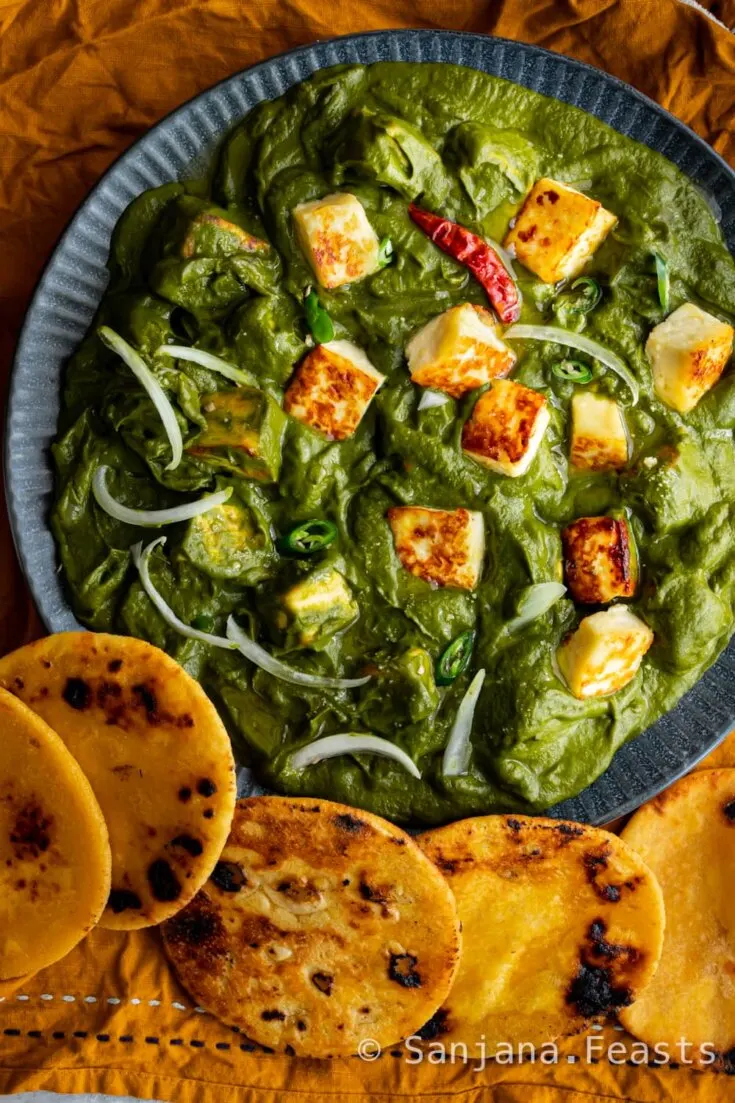



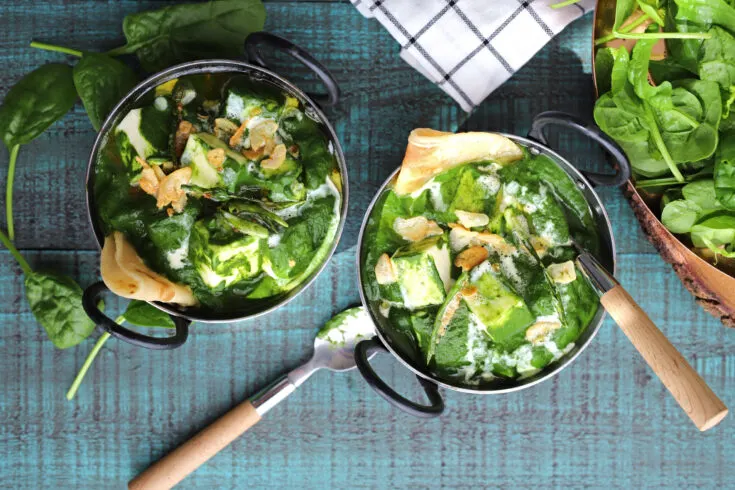
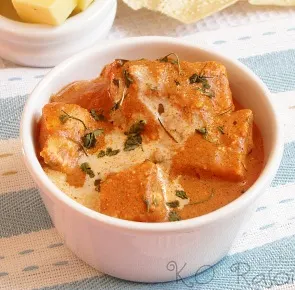

Malai Kofta - Sanjana.Feasts - Indian Curry Recipes
Friday 6th of December 2024
[…] Asia, Turkey, Persia and beyond, Mughlai cuisine introduced dishes like Biryani, Nihari, Korma, Keema and Pasanda to the Indian […]
afra
Friday 9th of February 2024
Lovely! (and I am not even vegetarian) I only changed the ratio a little using double onion/garlic/tomato/milk. Fabulous dish!
Amara Hosseini
Thursday 14th of September 2023
I couldn’t wait to make after seeing on Instagram. I had all the ingredients except paprika. I used red chilly powder instead. It was a superb meal, even the teens enjoyed and normally they are fussy. There weren’t left overs so I will miss it for lunch tomorrow but nexttime I’ll for sure double the recipe. Thanks